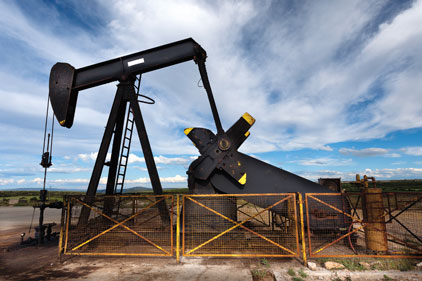For 2012, the most recent year for BLS calculations, oil and gas extraction businesses posted a total recordable cases rate of 1.5 cases per 100 full-time employees, well below the overall case rate for U.S. private industry of 3.4 cases per 100 employees.
More severe injury cases involving days away from work, job transfer or job restriction averaged 0.8 cases per 100 employees in the U.S. oil and gas extraction industry, well below the national rate for private industry of 1.8 cases.
The oil and gas continuum
Oil and gas extraction businesses operate and/or develop oil and gas field properties, either on land or off-shore. This is the “upstream” sector of the oil and gas industry, also known as the exploration and production sector. Activities include drilling, completing and equipping wells. The “midstream” sector transports crude or refined petroleum products by pipeline, rail, barge or truck; stores products; and markets product on the wholesale level. “Downstream” refers to refining petroleum crude oil; processing and purifying raw natural gas; and marketing and distributing products derived from crude oil and natural gas.
Drilling wells is more dangerous
Drilling oil and gas wells is a distinct industry from oil and gas production, as categorized by the BLS, and has experienced higher injury rates than the extraction industry as a whole. Establishments in this industry are primarily engaged in drilling oil and gas wells for others on a contract or fee basis. This industry includes contractors that specialize in spudding in, drilling in, redrilling, and directional drilling.
From 2003 to 2007, the most recent data available for drilling oil and gas wells, the number of total recordable cases of nonfatal injuries and illnesses ranged between 2,400 in 2003 and 4,700 in 2005, with 2007 having 4,200 cases. The rate of injuries and illnesses ranged from 4.0 per 100 full-time workers in 2003 to 6.8 in 2004, with a rate of 4.6 in 2007. This was a higher than the rate of 4.2 per 100 full-time workers for all industries in 2007.
The BLS Survey of Occupational Injuries and Illnesses collects case and demographic information on cases with days away from work. These are presumed to be the most severe cases. The rate of these cases in drilling oil and gas wells ranged from 1.5 in 2003 to 2.8 in 2004. The most recent rate was 1.7 per 100 full-time workers in 2007. The national average in 2007 was 2.1.
The PPE populace
The U.S. oil and gas extraction industry workforce consisted of 181,580 employees in 2012, according to the BLS. Primary users of personal protection equipment (PPE) are 22,650 extraction workers (on-shore and off-shore), 8,260 roustabouts, 6,670 construction workers, 4,740 maintenance workers, and 1,060 extraction work helpers.
Indicative of the growth in the U.S. oil and gas extraction industry, by September, 2013 total employment had reached 201,900, according to the BLS. In contrast, total employment in extraction in January, 2004 was 119,800, according to the BLS.
Problems with serious injuries & fatalities
Oil and gas extraction operators confront a safety challenge similar to other U.S. manufacturers and processing operations: the rate of minor injuries is low, better than the national average, yet serious injuries and fatalities (SIFs) are unacceptably high. From 2003 to 2009, 716 oil and gas extraction workers were killed on the job – a fatality rate seven times greater than the rate for all U.S. industries, according to OSHA.
Serious injuries in drilling oil and gas wells often result in fractures (25 percent of lost-time injuries in 2007) which have a median of 30 days away from work in recuperation, according to the BLS.
Safety cultures in the oil and gas industry
Training and use of specialized PPE is only part of building a culture of safety in the oil and gas industry. Safety cultures confront particular challenges in the oil and gas business.
Many new hires must be oriented to safety. The transient nature of employment in the industry may lead to apathetic commitments to safety.
The “macho” image of the work also can lead to recklessness and disinterest in safety.
The remoteness and isolation of some of the work may lead to substance abuse problems.
Much of the work is done by outside contractors that may be small and lacking staff safety expertise. Contractor oversight by the host company and insistence on adherence to company safety protocols such as fall protection procedures is critical.
This emphasis on safety is only possible if senior leadership of oil and gas industry companies are committed to and actively involved in the safety culture. The industry was put on notice in 2013 by U.S. Secretary of Labor Thomas Perez, who said, “Job gains in oil and gas have come with more fatalities, and that is unacceptable. We can and must do better.”
Reducing falls – a leading hazard in the oil and gas industry – is aided by strong, durable safety cultures. This emphasis on safety leads to good housekeeping practices; use of job safety analyses of tasks; risk assessments and risk management of hazards; attention to complacency, fatigue and the need for good communication between workers; a shared responsibility for safety; pre-shift safety talks; accident and near-miss investigations and safety alerts. All of these safety culture components contribute to increased safety in the oil and gas industry.






